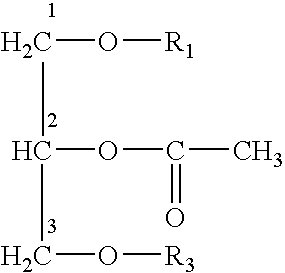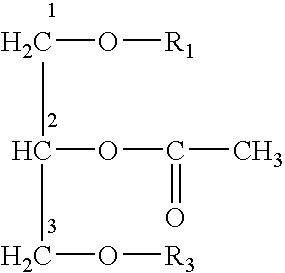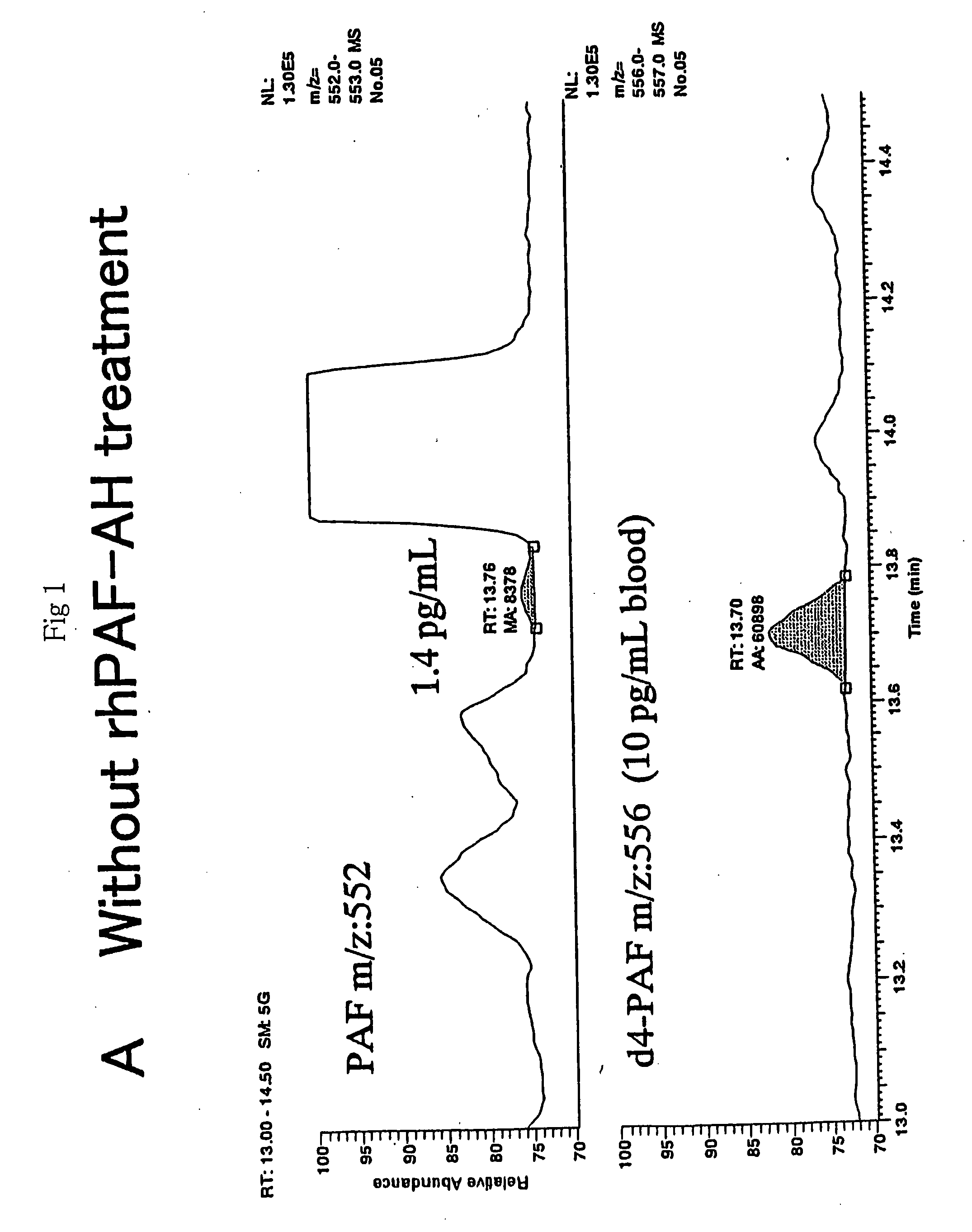Assay method for platelet-activating factor
a technology platelet aggregation, which is applied in the field of platelet activation factor assay, can solve the problems of difficulty in assaying paf, inability to specifically determine paf by biological activity assay methods, and inability to identify paf. specificity
- Summary
- Abstract
- Description
- Claims
- Application Information
AI Technical Summary
Benefits of technology
Problems solved by technology
Method used
Image
Examples
example 1
Yield of PAF by Total Procedure
[0096] Table 1 shows the yields of PAF, PC and LysoPC through the total procedure, using human blood. After adding 1 mL of human blood to a tube containing 4 mL of tetrahydrofuran, [.sup.3H]PAF, [.sup.14C]-PC and [.sup.14C]-LysoPC were added and the mixture was stirred and centrifuged (3000 rpm.times.15 min, 4.degree. C.). A 4 mL portion of ethyl acetate was added to the resulting supernatant and the mixture was stirred and centrifuged. The resulting supernatant was loaded into Bond Elut SI.TM., and then washed with 8 mL of hexane / 2-propanol / water=70 / 40 / 5 and eluted with 3 mL of hexane / 2-propanol / water=30 / 60 / 16. The eluted fraction was evaporated at 60.degree. C. under a nitrogen stream and the resulting residue was dissolved with 0.9 mL of 0.1 mM Bis-Tris buffer (pH 6.0, 10 mM CaCl.sub.2, 0.1% Triton X-100), 0.1 mL of a phospholipase C solution (10 U / mL) was added, and the resulting mixture was incubated at 37.degree. C. for one hour. The reaction mix...
example 2
Selection of PAF Extraction Solvent
[0098] A 1 mL sample of human blood was added to each tube containing 4 mL of different solvents, and then [.sup.3H]-PAF was added before stirring. The sample was centrifuged (3000 rpm.times.15 min, 4.degree. C.) and the radioactivity (.sup.3H-PAF) in the supernatant was measured, to give the results shown in Table 2.
[0099] The yield of [.sup.3H-PAF] in the supernatant was highest with tetrahydrofuran, followed by dioxane, acetonitrile and 2-propanol.
2TABLE 2 Yields of PAF with various solvents [.sup.3H]-PAF yield (%) Tetrahydrofuran 98.1 .+-. 4.5 Dioxane 97.1 .+-. 3.1 Acetonitrile 95.1 .+-. 2.5 2-propanol 93.2 .+-. 5.5 Acetone 85.3 .+-. 5.0 Ethanol 85.0 .+-. 3.3 Methanol 77.0 .+-. 4.0 Mean .+-. SD (n = 3)
example 3
Investigation of PAF Peak Specificity
[0100] The uniformity of the PAF peak with gas chromatography was verified using rhPAF-AH, and the results are shown in FIG. 1. After extracting PAF from 1 mL of human blood using tetrahydrofuran and ethyl acetate according to the method described in Example 1, the resulting ethyl acetate extract was purified with Bond Elut SIR. The sample was dissolved in 0.5 mL of buffer solution containing 40 pg of rhPAF-AH, and the solution was incubated at 37.degree. C. for one hour. It was then treated according to the method described in Example 1, pentafluorobenzoylated, and subjected to analyzed by GC-MS.
[0101] For the sample untreated with rhPAF-AH, peaks for PAF and the internal standard ([.sup.2H.sub.4]PAF) appeared at retention times of 13.76 minutes and 13.70 minutes, respectively, as shown in FIG. 1-A. For the sample treated with rhPAF-AH, however, these peaks had completely disappeared as shown in FIG. 1-B. These results indicated that the peak de...
PUM
| Property | Measurement | Unit |
|---|---|---|
| Fraction | aaaaa | aaaaa |
| Fraction | aaaaa | aaaaa |
| Fraction | aaaaa | aaaaa |
Abstract
Description
Claims
Application Information
 Login to View More
Login to View More - R&D
- Intellectual Property
- Life Sciences
- Materials
- Tech Scout
- Unparalleled Data Quality
- Higher Quality Content
- 60% Fewer Hallucinations
Browse by: Latest US Patents, China's latest patents, Technical Efficacy Thesaurus, Application Domain, Technology Topic, Popular Technical Reports.
© 2025 PatSnap. All rights reserved.Legal|Privacy policy|Modern Slavery Act Transparency Statement|Sitemap|About US| Contact US: help@patsnap.com



